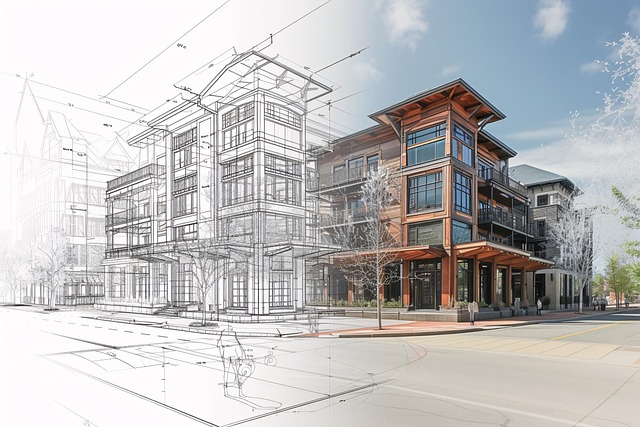Building Information Modeling (BIM) is transforming the architecture and construction industry by replacing traditional 2D detailed architectural blueprints with intelligent, three-dimensional digital models. This technology enhances collaboration among architects, engineers, and contractors, improves communication, reduces errors, and streamlines design processes. BIM enables real-time changes across all linked models, leading to more efficient workflows, better project outcomes, and cost savings during construction. It offers a comprehensive digital solution that incorporates functional data, ensures consistent information for stakeholders, and accelerates project timelines while enhancing quality and accuracy in architectural blueprints throughout the building's lifecycle. Future prospects include improved interoperability through cloud-based platforms for remote collaboration and sustainable decision-making.
In today’s collaborative construction landscape, efficient communication is paramount. Building Information Modeling (BIM) offers a game-changing solution for seamless project coordination. This article explores BIM’s transformative impact on architectural workflows, with a focus on its benefits for creating detailed architectural blueprints.
We’ll guide you through the transition to BIM-integrated drafting, highlighting best practices and future prospects. Discover how BIM enables enhanced collaboration, improved design accuracy, and more efficient construction processes, ultimately streamlining your architectural projects.
Understanding BIM and Its Impact on Collaboration
Building Information Modeling (BIM) is transforming the way architects, engineers, and construction professionals collaborate on projects. Unlike traditional 2D detailed architectural blueprints, BIM provides a comprehensive, three-dimensional digital model that includes all project data. This integrated approach enhances communication and coordination among team members, enabling them to visualize, analyze, and modify designs in real-time.
By utilizing BIM, project stakeholders can identify potential conflicts early in the design process, avoiding costly changes later. The centralized nature of BIM data ensures everyone works with the most up-to-date information, streamlining workflows and improving overall efficiency. This level of collaboration fosters better decision-making, reduces errors, and ultimately contributes to successful project outcomes.
The Transition to BIM-Integrated Drafting
The transition to BIM-integrated drafting represents a significant shift in the architecture and construction industry, moving away from traditional 2D detailed architectural blueprints. This new approach leverages digital technology to create intelligent, three-dimensional models that serve as a shared platform for all project stakeholders. By integrating various disciplines such as structural, mechanical, electrical, and plumbing systems within a single model, BIM enables seamless collaboration and coordination among architects, engineers, contractors, and clients.
This transition facilitates better communication, reduces errors, and streamlines the design process. With BIM, changes can be made in real-time, with updates propagating across all linked models, ensuring everyone works on the latest information. This collaborative environment enhances project visibility, improves quality control, and ultimately leads to more efficient construction processes and better outcomes.
Benefits of Using BIM for Detailed Architectural Blueprints
Using Building Information Modeling (BIM) for detailed architectural blueprints offers a multitude of benefits, revolutionizing the way architects and engineers collaborate. BIM allows for the creation of digital representations that capture not just the geometric aspects but also the functional and performance data of buildings. This comprehensive approach ensures that everyone involved in the project has access to up-to-date information, reducing errors and miscommunications that often plague traditional drafting methods.
Moreover, BIM facilitates seamless integration across various disciplines. Architects, structural engineers, MEP (mechanical, electrical, plumbing) specialists, and contractors can work concurrently on the same digital model, enabling real-time collaboration and coordination. This leads to faster project delivery, improved quality control, and cost savings through early conflict detection and resolution. Detailed architectural blueprints generated from BIM models are not only more accurate but also serve as a robust foundation for construction documentation, specifications, and project management throughout the building lifecycle.
Implementing BIM in Architecture: Best Practices and Future Prospects
Implementing Building Information Modeling (BIM) in architecture is a game-changer, transforming traditional drafting practices into a collaborative and efficient process. It involves creating detailed architectural blueprints that go beyond 2D representations, incorporating intelligent 3D models filled with data. This shift empowers architects to visualize and manage complex designs, ensuring better coordination among project stakeholders.
Looking ahead, the future of BIM in architecture promises enhanced interoperability, where various disciplines seamlessly share and update information in real-time. As technology advances, cloud-based platforms will play a pivotal role, allowing remote collaboration and enabling designers to access up-to-date projects from anywhere. This evolution will not only streamline construction processes but also contribute to more sustainable and informed decision-making throughout the building lifecycle.
BIM-integrated drafting represents a significant leap forward in architectural collaboration, streamlining processes and enhancing communication through a unified digital environment. By adopting this approach, architecture firms can achieve greater efficiency, reduce errors, and deliver more accurate and detailed architectural blueprints. As the industry continues to evolve, embracing best practices and staying informed about future developments in BIM will be key to unlocking its full potential and maintaining a competitive edge.
